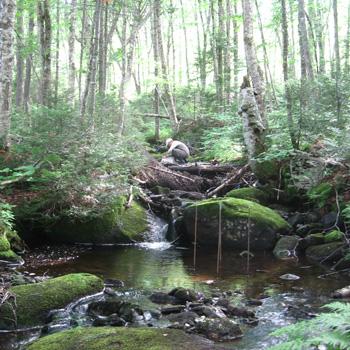Forest Succession and Terrestrial-Aquatic Biodiversity in Northern Forest Watersheds: Relationships, Causes, and Implications for Management

In northeastern forests, early-successional forest habitat is decreasing. It's important to learn how this trend affects both terrestrial and aquatic wildlife. NSRC researchers investigated how variation in forest successional stage (early vs. late-successional) influences terrestrial insect biodiversity and the input of terrestrial insects to streams as food for brook trout, the dominant salmonid in New England headwater streams. Researchers studied 12 northern New Hampshire watersheds that feed the Dead Diamond River. Study watersheds represented a range of early-successional habitat coverage (0 - 51%). Researchers sampled terrestrial and aquatic insects and brook trout diets within each stream.
Data indicate summertime diversity and biomass of flying terrestrial insects is greater in early-successional habitat than in late-successional habitat in northeastern forests, but terrestrial insect input to streams was unrelated to the amount of early-successional habitat in a watershed. Surprisingly, percentage of terrestrial insect biomass in brook trout diet was unrelated to terrestrial insect input to streams. Instead, researchers found that the amount of terrestrial insect biomass in brook trout diets was related to the availability of aquatic insects in streams. As aquatic insect biomass increased, percentage of terrestrial insects in brook trout diet decreased. Brook trout consumption of terrestrial insects is influenced less by variation in terrestrial insect input and more by the availability of aquatic insects.
Early-successional habitat is important for maintaining insect biodiversity in the Northeast, but increasing the amount of early-successional habitat in watersheds will not increase terrestrial insect inputs to streams and fish. Maintaining healthy streams and aquatic insect populations is important for brook trout populations.
